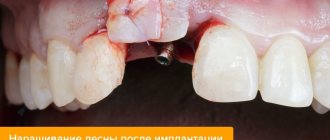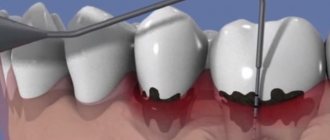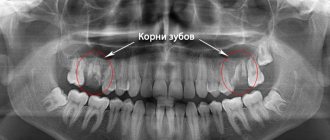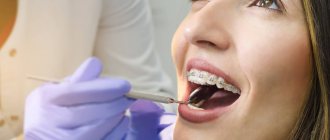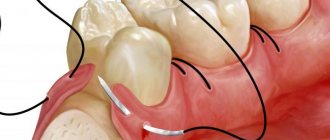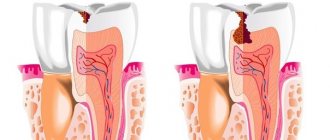Inflammatory processes in the gums indicate the presence of gingivitis or periodontitis. Gingivitis affects only the soft gum tissue. If the infection is not treated, the bacteria attack the connective tissue - periodontium. In advanced cases, both pathologies can lead to the need for surgical treatment: gingivectomy or gingivotomy.
The operations allow curettage of periodontal pockets, removal of abscess and excess tissue. The procedures differ in their methodology and indications.
What is gingivectomy?
Gingivectomy is a dental operation performed to remove inflamed or pathologically overgrown gum edges and reduce gum pockets. In the absence of timely treatment, the inflammatory process begins to affect deeper and deeper layers of tissue, thereby causing detachment of the gums from the walls of the tooth and the formation of pockets. In this case, gingivectomy allows not only to relieve inflammation in periodontal tissues and prevent its spread to bone tissue, but also to correct the gingival margin, solving the problem of aesthetic imperfections.
Existing indications for surgery
This surgical intervention becomes possible only if there are certain indications for gingivectomy, expressed in the following pathological changes:
- Hyperplasia of the gum margin (fibromatosis, periodontitis, hypertrophic gingivitis);
- Elongated natural tooth crown;
- Deformation and overhanging gums;
- Proliferation of the interdental papilla;
- Formation of periodontal pockets of pathological depth;
- For cosmetic and aesthetic purposes.
Despite the fact that this is a minor surgical intervention, it is not performed without special reasons. The purpose of the operation is justified if the problem cannot be solved with the help of drug treatment, or the depth of the periodontal pocket does not allow the use of the closed curettage technique.
Indications and contraindications for gingivectomy
Gingivectomy is prescribed only for strict indications, since it is, although minor, still a surgical intervention that requires the presence of certain pathological conditions. Surgery may be prescribed in cases where drug treatment has not brought a positive result.
Gingivectomy is indicated in the following cases:
— For various gum diseases, in which significant deformation of soft tissues occurs, due to which they become non-viable.
— With pathological growth of the gingival margin as a result of dental diseases such as gingitis and periodontitis. In severe forms of these diseases, periodontal pockets form, which help maintain inflammation in the gums and also serve as a reservoir for the accumulation of pathogenic microflora.
— With overhanging gums and minimal crown height. In this situation, gingivectomy is performed to improve the aesthetics of the smile.
- For hygienic reasons. Bacteria that accumulate in the gum pockets are not only a source of infection in the mouth, but also lead to inflammation of the soft tissues, followed by the process spreading to the bone tissue, which over time can even lead to tooth loss.
However, as with any surgical intervention, there are also a number of contraindications for gingivectomy.
The operation is contraindicated in the following cases:
— In the presence of an inflammatory process that has already affected the bone structures due to the possible risk of tooth loss.
- If the gum attachment area is too narrow, as this may lead to the impossibility of closing the resulting tissue defect.
- If there is a frenulum at the site of the intended incision.
— In the presence of deep intraosseous pockets.
— For diseases of the cardiovascular system in the acute period, weak immunity, diseases of the blood clotting system.
Gingivotomy
The surgical method is used to provide visual access when removing purulent contents from deep periodontal pockets. It significantly improves the quality of curettage and allows for antiseptic treatment of deep tissues.
Indications for surgery
The procedure is carried out if:
- • moderate to severe periodontitis with discharge of pus;
- • single abscesses;
- • periodontal pockets, more than 6 mm deep;
- • bone pockets.
Contraindications
The operation is not performed for osteoporosis of the jaw bones, diabetes mellitus, acute respiratory infections, infections in the oral cavity, severe pathologies of the heart and blood vessels, mental illness, exacerbations of chronic diseases, and degree 3 and 4 dental mobility.
Features of the method
The gum is dissected vertically, from the marginal zone to the transitional fold. The opened access allows for high-quality removal of granulation, pus, dental plaque and other pathological contents of periodontal and bone pockets.
Preparing for surgery
Surgical treatment is carried out only after an accurate diagnosis has been made. The patient undergoes laboratory and instrumental studies, which together show the clinical picture. Before the operation, professional cleaning is carried out, caries is treated, or the tooth is removed. The patient is prescribed vitamins and immunostimulants.
Executing the procedure
The surgeon’s manipulations take no more than half an hour, except for complex cases with the need to sanitation of deep lesions.
Gingivotomy consists of several stages:
- pain relief with local or general drugs;
- dissection of the gums;
- soft tissue departments;
- cleansing the affected area;
- treatment with drugs: enzymes, antiseptics, pastes with bioactive substances;
- suturing.
The dissection can be performed along the axis of the tooth, with a distal displacement, a semilunar line, or a T-shape.
How is the operation performed?
Before a gingivectomy, it is important to have a professional oral hygiene performed to remove plaque and tartar.
The operation itself lasts about 30 minutes, usually under local anesthesia. After anesthesia, the doctor treats the gums with an antiseptic solution and measures the depth of the gum pockets. Then the specialist excises the tissue with a scalpel or laser and removes the pathological edge of the gum. After this, curettage is performed - scraping of destroyed periodontal tissues, soft and hard microbial plaque). Upon completion of the operation, the doctor treats the gums with an antiseptic solution and applies bandages.
With a successful operation, complications are almost impossible. The recovery time for patients after this surgery is usually short. It usually takes 4-5 weeks for the gums to heal completely. Intense stress on the gums during the recovery period after surgery is contraindicated.
The main condition for the absence of complications after gingivectomy is compliance with the doctor’s recommendations, namely:
— Brushing your teeth with a soft toothbrush. - Avoiding eating solid, too cold or hot foods, quitting alcohol and smoking until the tissues heal. — Temporary limitation of chewing load.
How to get rid of a gum pocket
To get rid of the gum pocket, a surgical operation is performed - gingivectomy. It is possible with moderate severity of periodontitis, when cleaning the periodontal pocket from tartar, plaque and food debris, as well as medications no longer help. This can be explained by the fact that the gums, after removing stone and food debris, cannot immediately fit tightly to the body of the tooth. A person continues to consume food, and it again ends up in the gum pocket, rots and causes re-inflammation. To prevent this from happening, the edge of the gum must be trimmed a little, removing the gum pocket.
Get a gingivectomy at Dr. Granov's clinic!
Our dentists will carry out the necessary manipulations to get rid of the gum pocket, preventing more serious diseases!
Leave your phone number. The clinic administrator will call you back.
By leaving a request on the site, you consent to the processing of personal data
Make an appointment
Initial consultation with a dentist
400 rubles
Benefits of laser gingivectomy
Gingivectomy is performed using different methods: using traditional surgery with a scalpel or using a laser.
Thanks to minimizing the development of complications after surgery, as well as eliminating possible infections that occur during traditional surgery, laser gingivectomy is increasingly being used in modern dentistry. The use of a laser instead of a scalpel ensures faster healing, reducing the postoperative recovery period by several times.
Under the influence of a laser beam, the edges of the wound remain sterile, pathogenic microflora of the oral cavity are neutralized, and the risk of bleeding is minimized.
The main advantages of using a laser for gingivectomy:
— Complete absence of risk of infection — No or minimal blood loss — Exceptional precision of laser action — Short period of tissue regeneration, significantly shorter than with traditional surgery — No harm to healthy dental and periodontal tissues — No pain or discomfort — Minimal contraindications
What complications can occur after gingivectomy?
According to the observations of our dentists, complications develop quite rarely after gingivectomy. However, negative consequences can occur if the dentist is not aware of the patient's chronic immune system conditions. Periodontal disease and periodontitis are diseases that occur most often in patients with weakened immune systems. Gingivectomy can also cause complications in chronic connective tissue and cardiovascular diseases. This is explained by the fact that pathogenic bacteria can get into postoperative wounds. If the dentist has as much information as possible about the health status of his patient, he will be able to minimize the risk of such complications.
Laser gingivectomy in Krasnodar
Laser gingivectomy surgery in Krasnodar is performed at the highest level in the Symmetry clinic of modern dentistry and cosmetology. The guarantee of your beautiful and healthy smile is our experienced specialists and the most innovative equipment. In our clinic, vestibuloplasty is performed using modern and safe Doctor Smile D5 laser equipment.
You can find out more about a procedure such as laser gingivectomy by scheduling a consultation with our specialists: by phone in Krasnodar, or by using the feedback form. The cost of laser gingivectomy in Krasnodar is indicated in the Cost of Services section.
Cost of treatment
The final price of the operation is influenced by many factors: procedure technique, area of the operated area, type of anesthesia. If anesthesia or sedation is used, the cost will increase.
When using laser equipment, the price will be higher than when using a scalpel. However, the risk of complications is significantly reduced, and gum health will be restored faster.
Dental surgeons at our clinic use modern equipment. We use safe drugs for sedation or anesthesia. Prices are discussed with the patient before treatment begins.
Stages of the procedure
- Professional oral hygiene. The doctor removes soft and hard plaque manually or using an ultrasonic device. Mechanical manual cleaning uses special dental instruments, brushes and professional pastes.
- Anesthesia. Local anesthesia is usually used. An anesthetic drug is selected for each patient. If a person does not know whether he has an allergy, then a test is performed on him - an injection is given in the forearm. If the patient is prone to allergic reactions, then he is referred for testing.
- Measuring the depth of periodontal pockets with a special instrument.
- Incision of the gums with a laser or scalpel.
- Removal of dental plaque.
- Excision of excess gum tissue.
- Treatment of the intervention area with an antiseptic drug.
- Stop bleeding (if necessary).
- Applying a sterile dressing.
Main contraindications
Corresponding manipulations are not carried out in case of severe pathologies of the immune and endocrine systems, diagnosis of cardiovascular diseases, malignant neoplasms, as well as in case of insufficient zone of keratized gum tissue. The procedure is contraindicated for liver cirrhosis, viral hepatitis and bleeding disorders.
We reviewed the indications and contraindications for gingivectomy. In each specific case, consultation with a qualified specialist is required. Dentists at the AlfaDent clinic with extensive clinical experience will conduct the necessary examinations, diagnose and select the most correct technique.
Recommendations for recovery
The stronger the patient’s immunity, the faster the wound will heal. The speed of rehabilitation also depends on the gingivectomy method used. If the laser technique was used, the recovery time is reduced. In order to help the body return to normal after surgical dental intervention, it is necessary to follow a number of recommendations:
- Brush your teeth regularly with a special toothpaste.
- During daily hygiene and after each meal, use mouth rinse.
- Brush your teeth with a soft-bristled brush.
- Do not overload the jaw. Avoid solid foods (nuts, crackers, chewing gum, hard toffee, apples, etc.) during rehabilitation.
- Give up bad habits (smoking, alcohol).
- Follow the recommendations of your doctor and adhere to a gentle diet.
- Avoid eating too salty, sour and spicy foods, as well as too cold and hot drinks.
All of the above tips will help you avoid complications and speed up the healing process of a wound in the oral cavity. Once the gum surface has completely recovered, you can return to your normal lifestyle.
Postoperative period
After surgery you need to stick to a diet. Food should be neutral in taste, solid foods should be excluded. Also during this period it is better to give up smoking and alcohol. This will speed up the healing of wounds.
Oral hygiene should be carried out with extreme care and thoroughness. During the recovery period, it is necessary to use a soft toothbrush, special rinses and ointments.
To avoid complications such as wound suppuration, infection, and the spread of pathogens through the bloodstream, the doctor may prescribe a course of antibiotics and other wound-healing medications.
Important! In case of increased body temperature, severe pain and other unwanted symptoms, you should contact your doctor.
Gingivectomy price in St. Petersburg
| Name | Price |
| Closed curettage (6 teeth) | from 7,000 rub. |
| Open curettage (1 tooth) | from 2,200 rub. |
| Vestibuloplasty | from 6,600 rub. |
| Splinting (1 tooth) | from 1,650 rub. |
| Cosmetic gum correction (1 tooth) | from 2,200 rub. |
| Treatment of periodontal disease | from 1,000 rub. |
| Periodontal cleaning | 6,000 rub. |
Symptoms of gingivitis
In most cases, the growth of gum tissue is noticeable to the naked eye: periodontal tissue overlaps the dental crowns, making the teeth look short and recessed. A complication in this situation can be gingivitis. The presence of inflammation can be determined by the following symptoms:
- Bleeding gums when brushing teeth.
- Redness, swelling of the gums.
- Bad breath.
- The presence of hard or soft dental plaque.
- Pain when eating hot, cold or hard foods.
With mild forms of gingivitis, its treatment can be conservative. The doctor will prescribe antibiotics, antiseptics and painkillers, and also refer you to professional oral hygiene. Curettage is often performed - cleaning the gum pockets. However, if gingivitis causes them to enlarge, the patient will be indicated for gingivectomy.





